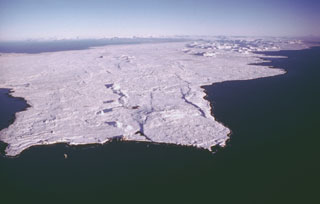Report on Reykjanes (Iceland) — 9 July-15 July 2025
Smithsonian Institution / US Geological Survey
Weekly Volcanic Activity Report, 9 July-15 July 2025
Managing Editor: Sally Sennert.
Please cite this report as:
Global Volcanism Program, 2025. Report on Reykjanes (Iceland) (Sennert, S, ed.). Weekly Volcanic Activity Report, 9 July-15 July 2025. Smithsonian Institution and US Geological Survey.
Reykjanes
Iceland
63.817°N, 22.717°W; summit elev. 140 m
All times are local (unless otherwise noted)
The Icelandic Meteorological Office (IMO) reported that an eruption began on 16 July in an area NE of Stóra Skógfell, along the Sundhnúkur crater row, within the Reykjanes volcanic system. IMO issued a Volcano Observatory Notices for Aviation (VONA) at 0106, raising the Aviation Color Code to Red (the highest level on a four-color scale), after monitoring data indicated a dike intrusion. An intense seismic swarm that began at 0120 was located between Stóra-Skógfell and Sýlingarfell, and deformation data indicated that the dike was propagating towards the S and rising to the surface. A fissure eruption began at 0356. The eruption was observed in webcams along with both drone and helicopter overflights. Lava fountains rose along the fissure, but no ash was present in the air; the Aviation Color Code was lowered to Orange at 0435. By 0505 the fissure was 700-1,000 m long and opening towards the N. Lava fountains continued to rise along the fissure and lava flows traveled mostly SE. Seismicity had decreased by 0845. Lava flows advanced W and to a greater extent to the E. Pele’s hair drifted downwind. High levels of volcanic gases were measured in Reykjanesbær prompting authorities to advise residents to stay indoors. By noon two fissures were erupting; the larger fissure at the Sundhnúkur crater row was about 2.4 km long, and a smaller fissure, about 500 m long, had opened W of Fagradalsfjall.
Geological Summary. The Reykjanes volcanic system at the SW tip of the Reykjanes Peninsula, where the Mid-Atlantic Ridge rises above sea level, comprises a broad area of postglacial basaltic crater rows and small shield volcanoes. The submarine Reykjaneshryggur volcanic system is contiguous with and is considered part of the Reykjanes volcanic system, which is the westernmost of a series of four closely-spaced en-echelon fissure systems that extend diagonally across the Reykjanes Peninsula. Most of the subaerial part of the system (also known as the Reykjanes/Svartsengi volcanic system) is covered by Holocene lavas. Subaerial eruptions have occurred in historical time during the 13th century at several locations on the NE-SW-trending fissure system, and numerous submarine eruptions dating back to the 12th century have been observed during historical time, some of which have formed ephemeral islands. Basaltic rocks of probable Holocene age have been recovered during dredging operations, and tephra deposits from earlier Holocene eruptions are preserved on the nearby Reykjanes Peninsula.

